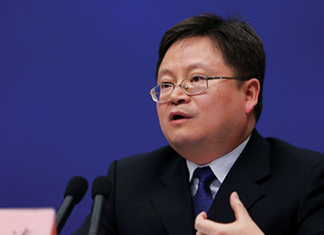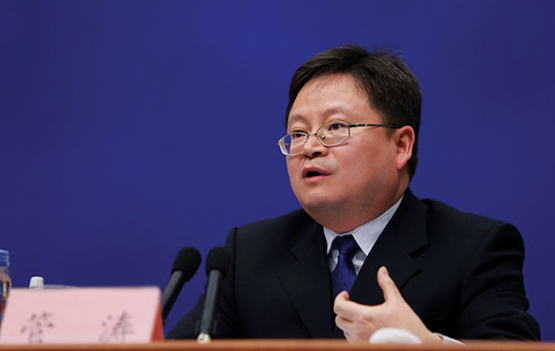Excessive Currency Supply: Can China Buy the Entire United States?
- Caifu Magazine | by CAIFU Magazine
- EN

CAIFU Editor's Note: Many people view the increase of money supply (M2) in China as a simple issuing of currency. If we look at the annual amount of trillions in high-speed rail investments, we will see that although it is manifested as an increase in M2, it also corresponds to the increase of all social wealth. Guan Tao, former director of the International Balance of Payment Department in the State Administration of Foreign Exchange, explained the issue more clearly, adopting the concept of a national balance sheet.

By Guan Tao, former director of the International Balance of Payment Department in the State Administration of Foreign Exchange
Since the international financial crisis in 2008, China's money supply has risen rapidly. The broad money supply (M2) has surpassed the scale of 100 trillion since early 2013, and its ratio to the gross domestic product (GDP) has reached to 209.1 percent by the end of 2016, a huge increase of 60.4 percent compared with 2008. This is considered an excessive money supply, pushing up the financial leverage and exacerbating the bubble of domestic assets. Moreover, since 2014 when the pressure of capital outflow increased and the national foreign exchange reserves fell, the ratio of foreign exchange reserves to M2 fell to 13.4 percent at the end of 2016, down 14.6 percent from the end of 2008. This worried the market for the sufficiency of China's foreign exchange reserve. There’s the notion that the so-called excessive money supply in China will make it possible to buy the United States as long as RMB does not depreciate. This is totally misleading if we look at it from the national balance sheet perspective.
We can obtain a broader and more comprehensive understanding of the issue if we look at it in terms of the national balance sheet.
A complete national balance sheet usually consists of four sub-sheets, which include the balance sheets of the government, the balance sheets of citizens, the balance sheets of industries, and the balance sheets of banking institutions. It is the record of a country’s total assets and properties at a given point of time.
Compared with the traditional system of national economic accounting, adopting the national balance sheet to analyze economic activities has its unique advantages. On the one hand, GDP is about flow, reflecting the economic activities of a country during a certain period of time, but does not reflect any previous economic activities, especially the materialization of them, that is, wealth. On the other hand, the national balance sheet is about stock, taking into account the impact of previous economic outcomes on current economic activities and evaluating the impact of current ones on future outcomes. In the following analysis, we utilize the national balance sheet made by the Chinese Academy of Social Sciences and compare it with that of developed countries.
In terms of the stock of wealth, China's M2/GDP ratio is not too high
First we look at the asset/GDP ratio, which is 15.9, 18.9, 21.4, 18.8 and 15.4 for the United States, Japan, the United Kingdom and Canada respectively, and only 11.6 for China (Figure 1), which is 35 percent lower than 17.9, the average level of the above four countries.
Then we look at the financial assets/GDP ratio of the same period. The U.S., Japan, the U.K. and Canada scored 11.6, 13.1, 17.5, 7.2 and 10.7 respectively, and only 6.0 for China ( Figure 2), which is 55 percent lower than 13.2, the average of the four.
In other words, even in terms of a bubble measured by the ratio of assets or financial assets to GDP, China is certainly not the most severe case compared with most developed countries. Even if there are some bubbles, then they may well only be partial ones.
The Current Bias over China's Monetary Stock
M2 is the currency stock in circulation, mainly consisting of cash in circulation, demand deposits, fixed term deposits and savings deposits. Cash, savings and deposits are forms of a people’s wealth accumulation in the process of economic growth, which is counted as the Financial Assets under Total Assets category in the national balance sheet. The current concerns over Chinese currency stock are all biased, either focusing only on the debt attribute of M2 and ignoring its asset attribute, or simply equaling the M2/GDP ratio to the degree of asset bubblization.
In terms of debt, M2/GDP ratio reflects the financial leverage in corporate sectors and household sectors, while in terms of asset; it is also part of financial assets/GDP equation. Asset-wise, the ratio of China's household savings to its GDP has increased from 54.5 percent at the end of 2002 to 73.9 percent at the end of March 2017, which reflects a healthy development where people enjoyed the fruit of a “people-oriented” economic policy. What should be of concern, however, is that the proportion of household savings to the national total in various financial institutions has dropped from 51.1 percent to 41.9 percent. This is partly due to the long-standing imbalanced pattern of national income distribution favoring corporations and governments.
It may be inadequate to measure the sufficiency of foreign exchange reserves using Foreign Exchange Reserves/M2 ratio.
During the Asian financial crisis in 1997, the Chinese government promised not to depreciate the RMB, but it did not use its foreign exchange reserves to support the stability of the RMB exchange rate. Therefore, during that period, nobody ever questioned whether China’s 140 billion foreign exchange reserves were enough or not. Now, in order to cope with the continued net outflow of capital, it chose to reduce its reserves and maintain the exchange rate as an important means. Since the end of June 2014 when its foreign exchange reserves fell from its peak, China's foreign exchange reserves has decreased $984.1 billion USD by the end of March 2017, and 65 percent of which occurred after the 8.11 foreign exchange reform in 2015. Thus there arises a huge cry both at home and abroad about the sufficiency of China's foreign exchange reserves, even though it is still sitting on nearly three trillion of them.
Our Main Conclusions
Assets and liabilities are two sides of a coin. If you look only at the M2/GDP hike bringing higher level of leverage risks, then you tend to forget that it is in itself also a reflection of the increase of social wealth accumulation, which is pigeon-holed and may lead to an exaggeration of the financial risks. In turn, this could trigger some overreactions from the market and policy making. In terms of the national asset/liability ratio, China's debt risks are largely under control, and there’s no need to be self-defeating.
If we measure a country's degree of financialization using financial assets/GDP ratio, then we’ll see there is still much room for China. We should not be put off this easily, and we should keep our development forward and solve the problems along the path. In practice, both the problems of high savings and high real estate portions at the asset side, or the financing difficulties and high financing costs for corporations at the debt side must be solved through financial reform to increase financial supply. Especially for the potential risk of asset bubbles, any responsible government would certainly try best to steer away from the bubble burst to avoid any crisis outbreak as a radical way to solve problems.
Even the developed countries after the debt bubble burst in 2008 did not laissez-faire to completely let the market adjust itself autonomously. They adopted non-conventional measures of monetary policy to proactively respond to the crisis, minimizing the loss and ramping up the recovery.
We should seriously consider the high risks accumulated during China’s rapid development of deep financialization in recent years. Usually a financial crisis may come along with the relaxation of financial regulation. An important reason for that is that the rapid expansion of financial assets will exacerbate the risk of a resource mismatch. When the economy goes upward, the risk is often hidden. Once the economy goes in a downturn, the crisis will often burst out suddenly. There have been enough cases for that, whether it being the opening up of internal or external financial regulations, or whether it being an emerging market or developed countries. The U.S. deposit and loan crisis in the early 1980s was closely related to its relaxation on its control over institutions in their savings and lending practices.
Although the absolute speed of China's currency expansion in recent years is faster than the United States, considering the difference in economic growth, U.S. currency expansion is still relatively faster than China. As for China's M2, which is far more than the U.S., does not necessarily mean it can buy American assets. Don’t forget that in the past when the United States’ M2 were far more than China, there has never been such a thing as large-scale buy out China assets by the United States. Let alone to say that even if China now wanted to buy, then then United States would not necessarily sell; or even should it decide to sell, it would not sell for the current price. As for China, any major solution toward the problem of a high M2/GDP ratio, or governmental policy options, must not be through overseas asset allocation, but through the development of domestic financial market -- both for its internal market preferences for investment, and for the government’s consideration to maintain financial security.















